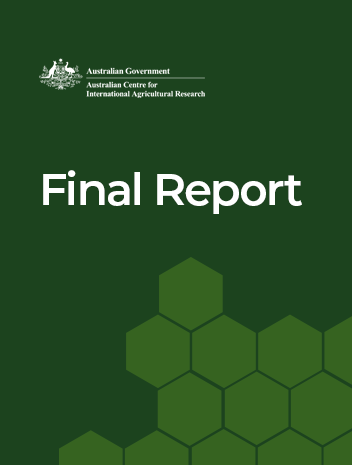- HomeHome
-
About ACIAR
- Our work
- Our people
-
Corporate information
- ACIAR Audit Committee
- Commission for International Agricultural Research
- Policy Advisory Council
- Agency reviews
- Executive remuneration disclosure
- Freedom of information (FOI)
- Gifts and benefits register
- Information publication scheme
- List of new agency files
- Contracts
- Legal services expenditure
- Privacy impact assessment register
- Commonwealth Child Safe Framework
- Benefits to Australia
- Careers
- 40 years of ACIAR
-
What we do
- Programs
- Cross-cutting areas
- Resources
- Where we work
-
Funding
- Research projects
- Fellowships
-
Scholarships
- John Allwright FellowshipScholarships to study in Australia for ACIAR partner country scientists to have Australian postgraduate qualifications
- ACIAR Pacific Agriculture Scholarships and Support and Climate Resilience Program
- Alumni Research Support Facility
- Publications
- News and Outreach
Project final report
Enabling community forestry in Papua New Guinea - Final Report
Date released
27 March 2023
ISBN
978-1-922787-78-1
Publication Code
FR2023-011
Overview
This project aimed to identify how community forestry in Papua New Guinea (PNG) could be better enabled and how it might be scaled up to achieve better economic, social and environmental outcomes.
The research focused on 3 main objectives; 2 on reforestation and the third on small holder natural forests as follows; 1) designing and testing novel tree-based livelihood systems for family-focused community-based reforestation; 2) methods by which family-focused community-based reforestation can be scaled-out to a landscape scale; 3) identifying and pilot testing institutional arrangements and policy recommendations which improve access to formal timber markets by smallholders.
Objectives 1 and 2, were aimed at family-based reforestation activities including agroforestry which could be scaled up across communities and the landscape. The research methods involved a combination of improving technology through training and extension activities which were also a means of collaborating with communities which also facilitated social-science and biophysical data collection. This collaborative approach with all stakeholders increased the understanding of the policy and institutional systems facilitated through meetings, conversations and visual observations.
Objective 3 was aimed at identifying institutional arrangements and policy reform that would allow communities better access to formal value-added timber markets. The research involved a combination of a literature review with thematic analysis of past small-scale forestry operations, a discounted cash flow (DCF) analysis of portable sawmill operations, a cash flow analysis of PNG log export revenue distributions to forest resource owners (FROs) over approximately three decades, and a descriptive case study of the Timber Authority (TA) regulations and the small-scale forestry informal market. We identified several policy reform options to allow communities better access to formal value-added timber markets.
Project outcomes
Following is sample of key findings. Further detail of the results is in the Final Report.
- Individual families will generally be the direct beneficiaries of efforts to reforest grasslands rather than the clans.
- Highly targeted, family-based, assistance may be more effective than participatory community-wide approaches to engagement.
- Local communities are heterogeneous in terms of interests. It is essential that outside agencies involved in extension understand the variety of interests and stakeholders within the population rather than assuming shared interests.
- Identifying services and benefits families and clans want to obtain from farm-based agroforestry and then discussing specific options is more beneficial.
- Women strongly prefer agroforestry or tree plots to be smaller and near to their homes; important for upscaling, designing and locating agroforestry systems in the Ramu/Markham Valley (RMV).
- Women and men often have different preferences for tree-based land use systems. Women tend to prefer planting trees mixed with food crops, not in rows. Men tend to prefer trees to be planted in rows to provide shade for cash crops.
- Cocoa agroforestry technologies that have been found to increase cocoa yield require additional labour and capital inputs that result in a decreased hourly wage equivalent being earned by smallholders.



